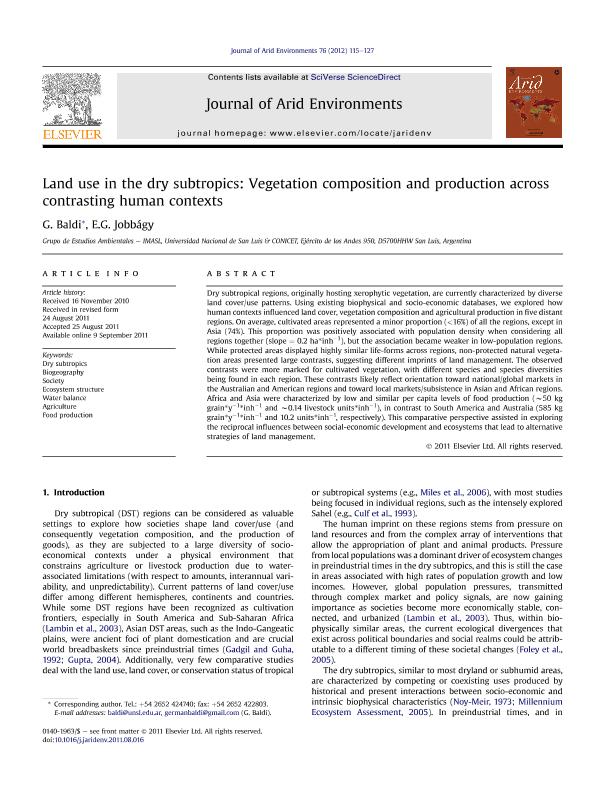Mostrar el registro sencillo del ítem
dc.contributor.author
Baldi, Germán

dc.contributor.author
Jobbagy Gampel, Esteban Gabriel

dc.date.available
2017-04-18T20:00:59Z
dc.date.issued
2012-01
dc.identifier.citation
Baldi, Germán; Jobbagy Gampel, Esteban Gabriel; Land use in the dry subtropics: Vegetation composition and production across contrasting human contexts; Elsevier; Journal of Arid Environments; 76; 1-2012; 115-127
dc.identifier.issn
0140-1963
dc.identifier.uri
http://hdl.handle.net/11336/15399
dc.description.abstract
Dry subtropical regions, originally hosting xerophytic vegetation, are currently characterized by diverse land cover/use patterns. Using existing biophysical and socio-economic databases, we explored how human contexts influenced land cover, vegetation composition and agricultural production in five distant regions. On average, cultivated areas represented a minor proportion (<16%) of all the regions, except in Asia (74%). This proportion was positively associated with population density when considering all regions together (slope = 0.2 ha∗inh−1), but the association became weaker in low-population regions. While protected areas displayed highly similar life-forms across regions, non-protected natural vegetation areas presented large contrasts, suggesting different imprints of land management. The observed contrasts were more marked for cultivated vegetation, with different species and species diversities being found in each region. These contrasts likely reflect orientation toward national/global markets in the Australian and American regions and toward local markets/subsistence in Asian and African regions. Africa and Asia were characterized by low and similar per capita levels of food production (∼50 kg grain∗y−1∗inh−1 and ∼0.14 livestock units∗inh−1), in contrast to South America and Australia (585 kg grain∗y−1∗inh−1 and 10.2 units∗inh−1, respectively). This comparative perspective assisted in exploring the reciprocal influences between social-economic development and ecosystems that lead to alternative strategies of land management.
dc.format
application/pdf
dc.language.iso
eng
dc.publisher
Elsevier

dc.rights
info:eu-repo/semantics/openAccess
dc.rights.uri
https://creativecommons.org/licenses/by-nc-nd/2.5/ar/
dc.subject
Dry Subtropics
dc.subject
Biogeography
dc.subject
Society
dc.subject
Ecosystem Structure
dc.subject
Water Balance
dc.subject
Agriculture
dc.subject
Food Production
dc.subject.classification
Ciencias Medioambientales

dc.subject.classification
Geografía Económica y Social

dc.subject.classification
CIENCIAS SOCIALES

dc.title
Land use in the dry subtropics: Vegetation composition and production across contrasting human contexts
dc.type
info:eu-repo/semantics/article
dc.type
info:ar-repo/semantics/artículo
dc.type
info:eu-repo/semantics/publishedVersion
dc.date.updated
2017-04-18T14:26:03Z
dc.journal.volume
76
dc.journal.pagination
115-127
dc.journal.pais
Países Bajos

dc.journal.ciudad
Ámsterdam
dc.description.fil
Fil: Baldi, Germán. Consejo Nacional de Investigaciones Científicas y Técnicas. Centro Científico Tecnológico San Luis. Instituto de Matemática Aplicada de San Luis; Argentina. Universidad Nacional de San Luis; Argentina
dc.description.fil
Fil: Jobbagy Gampel, Esteban Gabriel. Consejo Nacional de Investigaciones Científicas y Técnicas. Centro Científico Tecnológico San Luis. Instituto de Matemática Aplicada de San Luis; Argentina. Universidad Nacional de San Luis; Argentina
dc.journal.title
Journal of Arid Environments

dc.relation.alternativeid
info:eu-repo/semantics/altIdentifier/doi/http://dx.doi.org/10.1016/j.jaridenv.2011.08.016
dc.relation.alternativeid
info:eu-repo/semantics/altIdentifier/url/http://www.sciencedirect.com/science/article/pii/S0140196311002564
Archivos asociados
